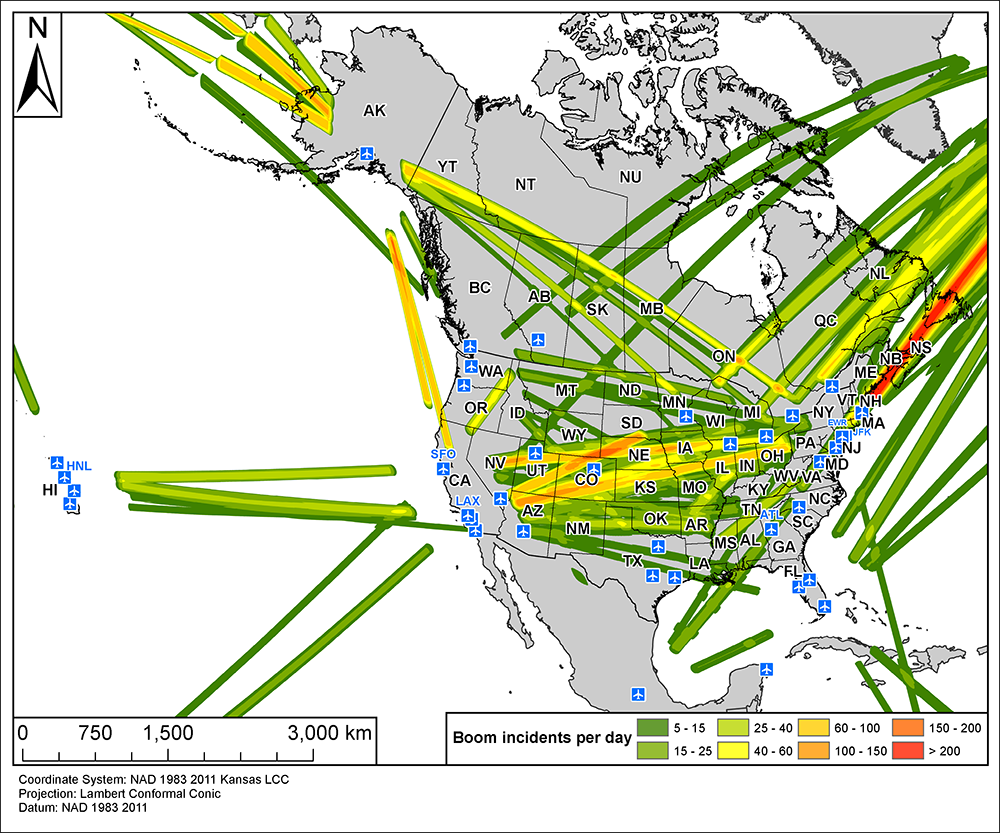Noise and climate impacts of an unconstrained commercial supersonic network
Press release
The environmental and health impacts of a new generation of supersonic aircraft could be immense
Parts of Western Europe and North America could experience sonic booms every 5 minutes
Emerging commercial supersonic aircraft could create severe environmental and health impacts by 2035 if plans being put forward by aviation startups, their investors, and the Trump administration succeed.
That is the conclusion of a new study released today by the International Council on Clean Transportation (ICCT). The paper analyzes the landing and takeoff noise, sonic boom, and carbon dioxide (CO2) implications of introducing 2,000 new commercial supersonic transport (SST) aircraft serving 500 cities in 2035, a scenario envisioned by a prominent SST startup.
A 2,000 strong supersonic fleet would translate to approximately 5,000 flights per day at 160 airports located predominately in Europe, North America, the Middle East, Asia, and Oceana. The impacts, in terms of noise and climate pollution, would likely be severe.
The most heavily impacted regions, including Canada, Germany, Iraq, Ireland, Israel, Romania, Turkey, and parts of the United States, could be exposed to between 150 and 200 sonic booms per day, or up to one boom every five minutes over a 16-hour flight day. Exposure to aircraft noise has been linked to sleep disturbance, learning delay in children, mental health problems, and heart disease.
The two busiest airports, Dubai International and London Heathrow, could see in excess of 300 supersonic flight operations per day. Other airports expected to experience 100 or more supersonic landing and takeoffs per day include Los Angeles, Singapore, San Francisco, New York-JFK, Frankfurt, and Bangkok. The aircraft could double the area around airports exposed to substantial noise pollution compared to existing subsonic aircraft of the same size.
The study estimates that the fleet of 2,000 aircraft – which could consume 5 to 7 times as much fuel per passenger as subsonic aircraft on the same routes – would emit 96 million metric tons (MMT) of CO2 per year. This is comparable to the combined annual emissions of US carriers American, Southwest, and Delta in 2017, and more than three times the emissions of Lufthansa Group, Europe’s largest combination of carriers, in the same year. The fleet would emit an additional 1.6 to 2.4 gigatonnes of CO2 over a 25-year service lifetime.
“Current supersonic sales targets, paired with ongoing efforts to lift overland flight bans, imply severe environmental consequences,” said ICCT’s Dan Rutherford, lead author of the study. “Manufacturers should commit to meeting existing standards for new subsonic jets and promise to adopt low boom technologies before further developing their aircraft.”
Three US-based startups are working to develop new supersonic transport aircraft, including a 55 seat commercial jet. Since 2016, advocates of supersonic flight have pushed to lift existing bans on overland flight in the US despite the objections of environmental and public health groups. Today, there are effectively no environmental standards for supersonic aircraft. The Trump administration, which favors permissive standards for SSTs, has clashed with Europe about their potential noise impacts.
International regulators will meet in Montreal for two weeks starting February 4th to discuss whether to apply existing subsonic standards to SSTs or to develop new, more lenient SST standards that would allow those aircraft to produce more noise, air, and climate pollution than new subsonic designs. “Supersonic manufacturers aim to sell as many as 2,000 supersonic jets by 2035,” said Brandon Graver, a paper co-author. “The public deserves to know how much these aircraft will pollute, and what safeguards their governments will adopt.”
Greenhouse gas emissions and air pollution from commercial aircraft are rapidly increasing. Treated as a country, the global aviation sector would have been the sixth largest source of carbon dioxide (CO2) from energy use in 2015, emitting more than Germany. CO2 emissions from global aviation hit an all-time high of 859 MMT in 2017, up 10% from 2015 levels.
The addition of supersonic aircraft would further erode efforts to keep global temperature rise to below 1.5 degrees, the limits of safe warming laid out by the Intergovernmental Panel on Climate Change. Emissions from 2,000 supersonic aircraft over 25 years corresponds to one-fifth of the CO2 that all international flights could emit this century under a 1.5 degree Celsius climate trajectory.
Publication details:
Noise and climate impacts of an unconstrained commercial supersonic network
Authors: Dan Rutherford, Brandon Graver, and Chen Chen
Download: www.theicct.org/publications/noise-climate-impacts-unconstrained-supersonics
Contacts:
Dan Rutherford, 650.336.3536, dan@theicct.org


# # #
The International Council on Clean Transportation is an independent nonprofit organization founded to provide first-rate, unbiased research and technical and scientific analysis to environmental regulators. Its mission is to improve the environmental performance and energy efficiency of road, marine, and air transportation, in order to benefit public health and mitigate climate change.